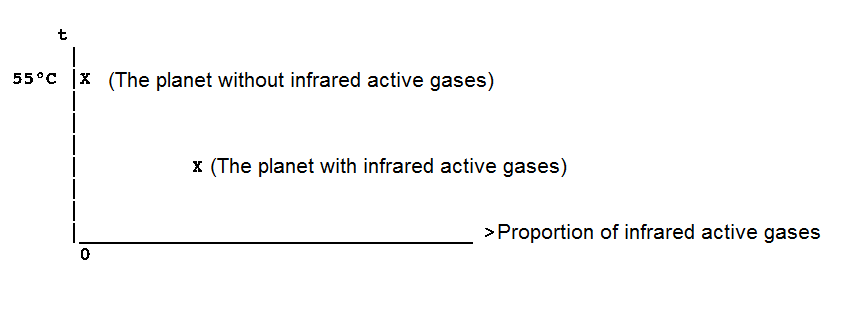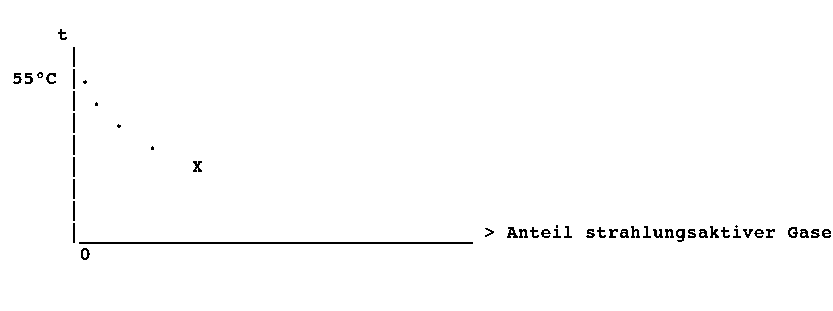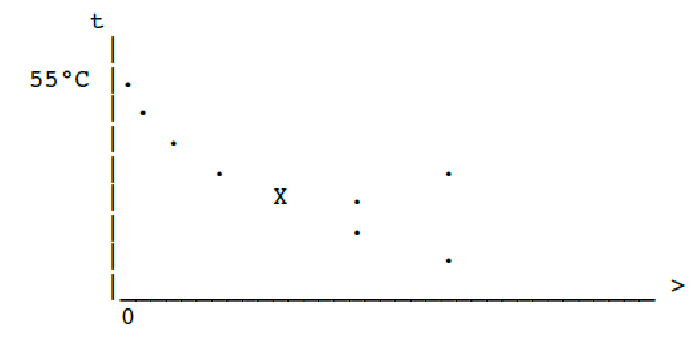A thought experiment over the climate of the Earth
Do you have the courage to make a thought experiment on the topic of climate? Indeed, the courage is needed to question what is taken as a given by society and is not to be questioned. You always need courage to confront society.
Let us start. Let us answer the following question: how would a planet like the Earth, whose atmosphere contains no infrared active gases*, look like? This question follows directly from the general demonization of infrared active gases as greenhouse gases.
* In the original "strahlungsaktive Gase"
I understand that it is impossible because each gas interacts with the radiation – but we're just having a thought experiment.
So that would be a planet with an atmosphere, which shows no interaction with the translucent radiation. The atmosphere can be heated or cooled down only by solid, liquid or gaseous bodies.
Let us start the experiment with an atmosphere that is colder than the surface of the planet. So it can be heated only from the planet's surface. The hot gases rise up because at the same pressure they need more space than cold gases. The hot gases accumulate at the top. The temperature of the hot gases above is not higher than the highest temperature ever measured at the surface of the planet. The highest temperature is now set in the entire atmosphere because the cooling of the atmosphere is no longer possible. The atmosphere can only cool down in direct contact with a cooler body. And the only cooler body available is the surface of the planet. But warm gases rise from the surface. Thus we get an atmosphere with the temperature of the warmest point on the planet's surface. A cold zone, which is quite thin, will form in direct contact with the surface. Winds will be weak because the atmospheric layers are stable: the cold gases in a small separation layer are in the bottom and the hot gases with the temperature of the warmest point on the planet's surface are on the top.
Is everything up here right?
That would mean that on the Earth the atmosphere is heating up slowly to the temperature of the Death Valley, and that a thin boundary layer forms at the surface of the planet. How thick this boundary layer is depends on the heat conduction within the gas – we have excluded the conductivity of heat by radiation. Thus in the Death Valley we shall have the boundary layer with a thickness of zero and in cold regions of the planet with a thickness from one to two meters. The Earth would be a grim place without radiation active gases.
Is everything up here right?
Consequently the atmosphere of our planet needs infrared active gases to get rid of heat coming from the center of the planet. In the course of the thought experiment we came just to what supporters of the theory of the greenhouse effect warn us – to the death of the planet from heat.
If we start with a high atmospheric temperature, then the heat conduction will bring the temperature down to the planet's surface. Ultimately it is a question of power, how high the temperature in the atmosphere is. And the gravity makes for a stable stratification.
Now we know a point in the following diagram. The atmosphere has 55 degrees Celsius and this temperature decreases in a thin layer near the surface of the planet.

Proportion of infrared active gases
The question now is how the atmosphere behaves when infrared active gases are added. When infrared active gases are added a reflection of the atmosphere starts. This radiation is disturbed easier in the upper layers. This leads to destruction of the stable stratification. Then a cold layer forms above and a circulation starts. Thus the warmest point in the atmosphere will be above the Death Valley, all other places will be colder. In the case of the imaginary planet the warmest layer is at the top, in the case of the planet with infrared active gases the coldest layer is at the top.

Proportion of infrared active gases
Now the question is how the curve will behave between these two points and to the right of the point of the planet with infrared active gases. It should be emphasized that the temperature conditions of the Earth are more complicated since the water vapor and the gas laws provide a complicated temperature gradient.
So the curve goes down. The first question is, therefore, whether the curve is digressively falling or progressively falling. If the radiated power exceeds the power that heats up the gas to 55°C, which happens very quickly, then the temperature drops dramatically because the surface of the atmosphere is substantially greater than the area of the Death Valley and on the night side of the planet there is no absorption, only reflection. The temperature, therefore, at a low addition of infrared active gases is decreasing very fast. It also leads immediately to an instability in the atmospheric layers. From this point of view, it will be a digressively falling curve.
Most likely we will focus on the following curve:

Proportion of infrared active gases
A key question now is whether the curve will maintain the trend of the digressively falling curve or, as proponents of the theory of the greenhouse effect state, it will begin to go up steadily.

Proportion of infrared active gases
So it is necessary to distinguish two cases. The case of the further temperature decrease upon further addition of infrared active gases and the case of the reversal of the observed effect. The reversal of the observed effect would mean that a strong absorption of the incident light occurs, as the representative of the greenhouse theory claim. A reversal of the effect would also mean that the power balance shifts significantly in the direction of the warming-up. It was described above how much warming is weaker then reflection. The experience of observation of the real atmosphere also shows that huge radiation windows are open into space. And they are open during day and night.
The next question is where the saddle point of the function will be and when the reversal takes place. It is far from obvious whether there really is an increase in temperature with further addition of infrared active gases. This can only happen if an increase is determined and the observed point is located in the area of the rise.
The claimed rise in temperature with the addition of infrared active gases is not observable. On the contrary, in the last twenty years there has been an increase of the infrared active gases at the stagnation of temperature. All this testifies in favor of the monotonically digressive curve. This all speaks for a decrease of the temperature with the addition of infrared active gases, for a strong cooling effect of the infrared active gases. That is what was planned to demonstrate with this thought experiment.
In a first approximation it seems more likely that greenhouse gases cool the atmosphere and not warm it as claimed by Fourier and Arrhenius.
Carsten Thumulla
13.4.2015
Addition from 29.04.2015:
These thoughts should lead us to the following important points:
1. The atmosphere needs infrared active gases for the cooling.
2. Only cooling of the upper atmosphere starts the process of changing direction of the atmospheric layers.
It is not an explicit refutation of the greenhouse effect. It's purely about the character of the curve. A monotonically falling curve is explained, an upward curve requires additional arguments.
It is not mentioned in the Text, that there is an adiabatic temperature decrease with height. This fact seems to me self-evident. You can compare the temperatures of the two models only in the same heights.
Addition from 10.05.2015:
The surface temperature of the planet is no longer equivalent to the atmosphere temperature after the onset of the infrared active gases. The infrared active gases isolate the transfer of energy through radiation. The point of the thought experiment is to clarify that the reflection of the atmosphere starts the change of direction of the layers.
Addition from 15.02.2017:
My initial assumption that the atmospheric column will be set to a uniform temperature was correct. Mixing of air leads to adiabatic relationships. As soon as the air calms down its behavior acquires features of isothermal. The conductivity should be improved at the height so an isothermal equilibrium will be established at the top even faster.
The pure heat conduction is 600m per year, 2m per day. So my estimation of the intermediate layer of few meters is not far from the truth.
as english PDF
Gedankenexperiment_Klima_Thumulla_eng.pdf
alle englisch Klimazirkus Startseite(__index)



